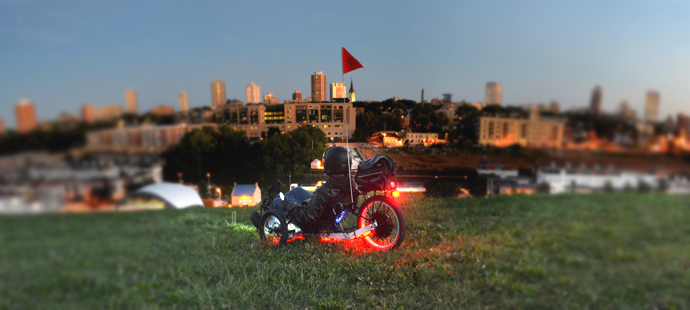
As the current crop of electric cars struggle to extend their range towards 200 miles, a new American-built electric trike boasts an autonomy of 300 miles.
The Odyssey electric trike is too powerful to be considered a cycle in law in Britain, but it offers a tantalizing glimpse of the performance and range that’s possible with extremely lightweight electric vehicles. To put its range in context, it is within striking distance of the fuel range of a petrol Ford Focus when city driving.

Odyssey trikes achieved this level of performance in part through 3d printing around a dozen components. They cite themselves as a tech company, not just a bike builder and have just finished work on a 3d printer they designed and built themselves. The 4 by 8 feet machine is capable of producing bicycle frame-sized 3d prints. Such additive manufacturing has the added advantage of producing very little waste.
In terms of price, range and usability the bicycle is the most practical option for those who want the benefits of an electric vehicle today.”
Electric vehicles of every description are currently in development, from aircraft to jet skis, but batteries remain expensive, heavy and troublesome to charge without widespread charging points.
Bicycles are easy to convert to electric power and light enough to be carried into a house to be re-charged. Furthermore, the electrically-assisted bicycle is the ultimate hybrid; if the battery runs flat, the rider can switch to leg power in an instant. There will be those who will scoff at the idea of an electric bicycle or trike, but for those who try them these vehicles will be a revelation. Electric bicycles are at their most efficient when the rider works in tandem with the motor; electrically-assisted bikes can make a 30-mile round-trip commute a realistic option for even a novice cyclist. They also make cycling more accessible for the elderly or disabled.
Electric two-wheelers: A missed opportunity?
The British government seems to have a blind spot where electric vehicles are concerned. The £5,000 grant towards plug-in electric cars costing over £20,000 was launched to great fanfare, but a more significant step towards personal electric transport could have been made had the initiative included electric bicycles and mopeds – not least because such vehicles are more affordable to buy and far less reliant on recharging infrastructure.
Under current British law, if an electric bicycle (pedelec) exceeds 200W or is capable of more than 15.5 mph it is considered a moped. Most fit cyclists on a moderately lightweight bicycle would be capable of prolonged speeds of 16 mph or over, but if that speed is even partially sustained by an electric motor, the law requires the same lights, paperwork and number plate as a moped.
We are still some time away from a wholesale switch to electric cars. Electric bicycles and motorcycles are here now. The Odyssey trike is too powerful to be considered a pedelec here in Europe, but arguably does not warrant classification as a full-blown motorcycle.
Our law will soon catch up with the rest of Europe and raise the maximum permissible power for a pedelec to 250W. In the meantime, the 99 per cent of British pedelec riders who ride a 250W bike can rest assured that the police, Department for Transport and the electric bike insurer ETA, will make allowances until the law finally changes.
Protection for you and your bike
ETA Cycle Insurance never devalues your bike, doesn’t charge extra for things like third party liability, personal accident or friends and family cover, and has a sympathetic policy on storage in sheds and garages.
For 25 years we have been providing straightforward, affordable bicycle insurance and in 2015 we were voted Britain’s most ethical insurer.
Find out more about why we are different. Get an instant quote or call our friendly team on 0333 000 1234.
Matt Hodges
My wife has an electric recumbent trike and it enables he to make local journeys at a reasonable speed despite her arthritis (She doesn’t Drive). But I fully support the restriction of assistance to 15.5 mph.
Yes most fit cyclists can maintain speeds well over 15 mph but only after experience and regular riding. They are capable of handling their bike safely at those higher speeds (even if some of them do sometimes ride dangerously.) Put a novice on a 30 mph electric bike without training and you have an accident waiting to happen. I see people on electric bikes with very little bike handling skill expecting everyone to get out of their way and never pedalling. Faster eBikes should have licensing, tests and Insurance. I certainly don’t want them using shared paths. They are motorbikes. Pedestrians will get hurt and it will be ALL bikes get the blame not eSuperbikes.
Nick
Faster ebikes with amaximum speed of say 20mph would be much more practical and enjoyable
and so would encourage far more people out of their cars for a greener commute or leisure transport.
The limit of 250w is way too low for a mum with a trike and 2 small kids or a courier bike. It would be better to have a max speed of 20 mph regardless of power but with an upper weight limit which could be somewhere below what is now classified as a light quadricycle. So much more could be done with such light inexspensive and green vehicles. Of course there would be little financial incentive for governments to allow this and if you think any government in the near future would put he environment before it’s own revenues or those of its friends in the motor industry – think again!